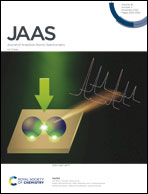Potassium isotopic composition of seven widely available biological standards using collision cell (CC)-MC-ICP-MS
Abstract
The development of collision-cell multi-collection inductively-coupled-plasma mass-spectrometers has revolutionized K isotope chemistry, improving the sensitivity by over a factor of 10 compared to that of older generation instruments. The application of isotope chemistry of metals in medical science (isotope metallomics) has shown significant growth in the last few years with respect to the study of metal cycles in the body and/or as diagnostic tools for diseases affecting metal homeostasis. Given the major role that K plays in biology through the preservation of cellular homeostasis itself, the generation of nervous impulses, and the formation of glycogen in the liver, the development of K isotope metallomics is imminent and necessary. To this end, we report the first set of high precision K isotopic data for numerous widely available biological reference materials, spanning both land and sea animals, as well as various bodily organs (muscle, kidneys, and liver). Results indicate that land animals are globally enriched in the lighter isotopes compared to sea animals, and that K isotopes are fractionated by more than 1.5‰ between organs (bovine), highlighting that K isotopes could be used to study K cycles within the body. These novel data—and reference materials—could be used for future interlaboratory comparisons.



 Please wait while we load your content...
Please wait while we load your content...